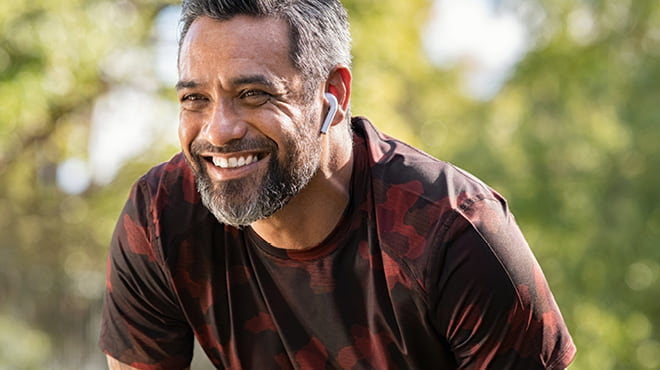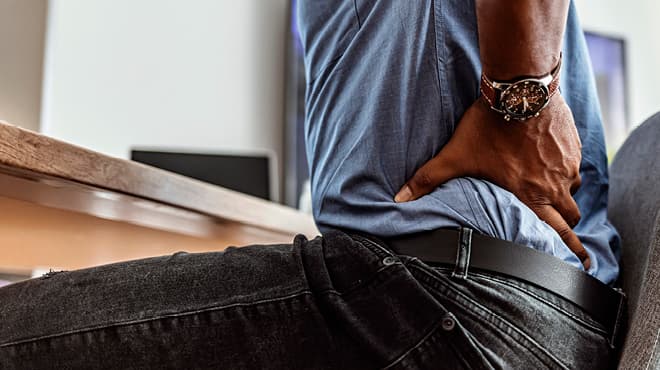Recent Posts
Sciatica and radiculopathy: Peculiar names for shooting back, leg pain

Most people have heard of sciatica and may have experienced it at some point. Sciatica refers to a sharp, shooting pain that runs from your lower back down the side or the back of your leg.
Sciatica is named after the sciatic nerve, which is the largest nerve in your body. It is about the diameter of your little finger and composed of five nerve roots that start in your lower spine. These nerve roots combine to form this large nerve that branches from your lower back through your hips and buttocks and down each leg.
Causes
Despite the name, sciatica is not typically caused by a problem with the sciatic nerve. In most cases, it is caused by compression of one of the nerve roots that make up the sciatic nerve, usually the last lumbar nerve root ― L5 ― or the first sacral nerve root ― S1 ― as they exit the spine. The term "pinched nerve" is commonly used when describing the condition. The medical term for the condition is radiculopathy.
The most common cause of radiculopathy is a herniated lumbar disc. When disc material protrudes from the disc space into the spinal canal, it can compress a nerve root. Radiculopathy can be caused by an accident, injury or lifting a large amount of weight improperly. However, most commonly people cannot link the onset of their symptoms to any event. They simply wake up one day to pain radiating down one leg.
Other causes of sciatica include lumbar stenosis, which is narrowing of the spinal canal leading to pinching of the nerve root, and spondylolisthesis, which is a slip forward of one vertebra on another.
Symptoms
When a nerve root is compressed, people experience three general symptoms: pain, numbness and weakness. Not everyone will experience all three symptoms.
Pain is the most common symptom, and it is usually a sharp, shooting pain along the nerve. It can vary widely, from a mild ache to a sharp, burning sensation or excruciating pain. Sometimes it can feel like a jolt or electric shock. It can be worse when you cough or sneeze, and prolonged sitting can aggravate symptoms. Usually only one side of your body is affected.
If the last lumbar nerve root is being compressed ― L5 radiculopathy ― the pain generally runs down the outside of side of the leg. If the first sacral nerve root is being compressed ― S1 radiculopathy ― the pain normally radiates down the back of the leg.
Numbness also is a common symptom. This can show as decreased sensation or tingling in the same way as sciatic pain. L5 radiculopathy is usually associated with numbness down the side of the leg and into the top of the foot. S1 radiculopathy typically results in numbness down the back of the leg into the outside or bottom of the foot.
Weakness is another symptom of nerve root compression. However, it is less common than pain and numbness. This displays as decreased function in the muscles supplied by the nerve root that is compressed. For L5 radiculopathy, this is usually weakness with bending the foot back toward your head. When severe, this can cause a foot drop with the foot slapping the ground when you walk. For S1 radiculopathy, there can be weakness with flexing the foot forward, like pushing down on a gas pedal.
Treatments
A range of treatments is available for radiculopathy, including:
- Activity modification
An important first step is to modify your activities, such as avoiding bending, lifting and twisting activities. This minimizes further irritation of the nerve root and allows your body to heal. - Medications
Over-the-counter medications, such as acetaminophen and ibuprofen, can effectively reduce pain. Your healthcare provider also may prescribe other medications, such as oral steroids, to reduce inflammation or a muscle relaxer if you are experiencing spasms in the muscles in your back. Generally, sciatic pain and radiculopathy are not treated with opioid pain medications. - Physical therapy and chiropractic therapy
These therapies also can effectively treat lower back problems, including radiculopathy. - Steroid injections
Some people find relief from targeted steroid injections into the lumbar spine directly around the nerve root that is irritated and compressed. Corticosteroid injections reduce pain by suppressing inflammation around the irritated nerve. - Surgery
This is an excellent treatment for L5 or S1 radiculopathy when other conservative, nonsurgical treatments have not worked. There are generally two reasons for surgery. The first is significant weakness, such as a foot drop. In these cases, the sooner pressure is off the nerve, the more likely you can fully recover. The second more common reason to have surgery is if conservative treatments have failed.
Usually, the most conservative treatments are recommended first and more invasive treatments are only pursued if necessary. Most cases of L5 or S1 radiculopathy will resolve within a few weeks or months.
When to see your healthcare provider
Most cases of sciatica or L5 or S1 radiculopathy are resolved with time and activity modification so most people will not need to see their healthcare provider.
Talk with your primary healthcare provider if your pain is severe or becomes progressively worse and is not relieved with over-the-counter medications, activity modifications or time.
You should seek immediate medical attention if:
- Your pain follows a recent traumatic event, such as a car accident or fall from a ladder. It's important to have a medical evaluation to make sure you don't have a serious spine fracture or instability.
- You had a recent bacterial infection or are experiencing symptoms of infection like fevers, chills and night sweats. In this case, you should seek medical attention to make sure an infection hasn't spread to your spine.
- You have a history of cancer.
- You are losing, or have lost, the ability to use any of the muscles in your legs, walk, or maintain bowel or bladder control.
The good news is that the symptoms of sciatica and L5 or S1 radiculopathy are treatable. Most people improve with time and appropriate treatment, and generally can avoid surgery.
Learn more:
- 6 most common types of chronic pain treated by neurosurgeons
- Back pain basics
- Feeling off balance? A nerve condition may be to blame
- When should I see a doctor about back pain?
T.K. Schiefer, M.D., is a neurosurgeon in Eau Claire, Wisconsin.






